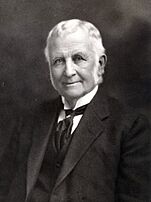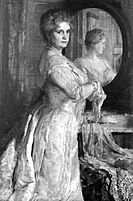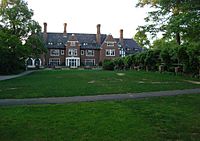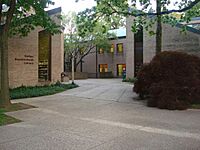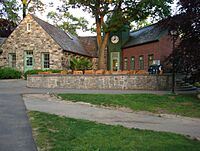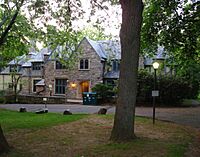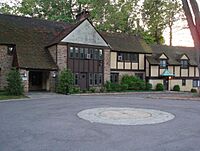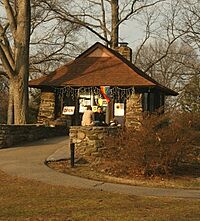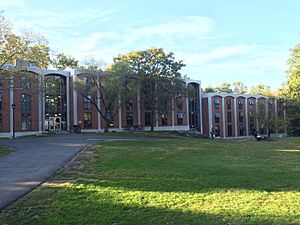Sarah Lawrence College facts for kids
 |
|
| Motto | Wisdom with Understanding |
|---|---|
| Type | Private liberal arts college |
| Established | 1926 |
|
Academic affiliation
|
|
| Endowment | $110.2 million (2020) |
| President | Cristle Collins Judd |
|
Academic staff
|
97 FT/ 200 PT (2023) |
| Students | 1,743 (2023) |
| Undergraduates | 1,521 (2023) |
| Postgraduates | 222 (2023) |
| Location |
,
,
U.S.
40°56′06″N 73°50′42″W / 40.935°N 73.845°W |
| Campus | Suburban, 44 acres (18 ha) |
| Colors | Green and white |
|
Sporting affiliations
|
NCAA Division III – Skyline Conference |
| Mascot | Gryphons |
 |
|
Sarah Lawrence College (SLC) is a private college in Yonkers, New York, United States. It's known as a liberal arts college, which means it focuses on a wide range of subjects like arts, humanities, and sciences.
The college was started in 1926 as a school just for women. In 1968, it became a coeducational school, meaning both men and women could attend. The campus is in Yonkers, New York, about 20 miles from New York City. The college's sports teams, called the Sarah Lawrence Gryphons, compete in the Skyline Conference as part of NCAA Division III.
Contents
History of Sarah Lawrence College
How the College Started and Grew
Sarah Lawrence College was founded in 1926 by a real estate developer named William Van Duzer Lawrence. He built the college on his own property in Westchester County. He named the college after his wife, Sarah Bates Lawrence.
At first, the college was meant to teach women about arts and humanities. A big part of the early learning involved "productive leisure." This meant students had to work eight hours a week in areas like modeling, typing, or gardening. The college also focused on students doing their own research projects. Teachers worked closely with individual students and in small classes. This way of teaching is still used today.
Sarah Lawrence was the first liberal arts college in the U.S. to combine strong arts programs with new ideas about education. It focused on teaching and helping each student with their own needs.
Harold Taylor was the president of Sarah Lawrence College from 1945 to 1959. He became president when he was only 30 years old. Taylor was friends with a famous education thinker named John Dewey. He worked to use Dewey's ideas at Sarah Lawrence. Taylor spent much of his career asking for changes in education across the U.S. He used Sarah Lawrence as an example of how education could be personal, modern, and challenging.
In 1968, Sarah Lawrence became a school for both men and women. Before this, there were talks about moving the school and joining it with Princeton University. But the college decided to stay independent.
College Presidents
The first president of Sarah Lawrence College was Marion Coats. She was president from 1924 to 1929. She was friends with the president of Vassar College and William Van Duzer Lawrence.
Cristle Collins Judd became the president in 2017.
College Rankings and Admissions
How Sarah Lawrence is Ranked
| USNWR Liberal Arts College | 108 |
|---|---|
| Washington Monthly Liberal Arts | 155 |
| Forbes | 467 |
Colleges in the U.S. are often ranked by different groups. In 2007, some people started to question these rankings. They wondered if the rankings truly showed how good a college was.
Michele Tolela Myers, a former president of Sarah Lawrence College, wrote an article about this. Sarah Lawrence College stopped requiring students to submit SAT test scores for admission in 2003. This meant they joined the "SAT optional movement." Myers said that SAT scores didn't help much in predicting how well a student would do at Sarah Lawrence. She also felt that SAT scores favored students who could pay for expensive test prep.
Sarah Lawrence College now has a "test-optional" policy. This means students can choose whether or not to send their test scores.
In 2022, Forbes magazine ranked Sarah Lawrence 467th overall among 660 colleges. Washington Monthly ranked it 155th among liberal arts colleges that same year.
Applying to Sarah Lawrence College
In 2024, Sarah Lawrence accepted about half of the students who applied (49.9%). Students who were accepted usually had a high school GPA of about 3.75.
The college does not require students to send their standardized test scores. For those who did send scores, the average SAT score was 1360. The average ACT score was 31.
Student Life and Activism
Political Involvement and Activism
Students at Sarah Lawrence have been involved in important causes for a long time. As early as 1938, students volunteered in Yonkers to help bring equality and education to people in need. During World War II, students formed the Sarah Lawrence College War Board to help the troops.
In the 1960s, students supported civil rights and protested against the Vietnam War. They also worked for more diversity among students and teachers in the 1980s. Students also started a program called Upward Bound. This program helps students from lower-income areas get ready for college.
Many other programs have been started since the 1970s to help the community. These include Theatre Outreach and the Community Writers program. Students have also held peaceful protests on campus to support better wages and working conditions for college staff. Sarah Lawrence College has often been a leader in movements for gay rights and other progressive causes.
Campus Life and Buildings
The Sarah Lawrence campus is about 42 acres. Much of it used to be part of the founder's estate. The campus has grown a lot since 1926. You'll see many large oak and elm trees and rocky areas. Many older buildings are in the Tudor Revival architecture style. Newer buildings often try to look similar.
The campus has two main parts: the "Old Campus" and the "New Campus." The Old Campus is where the original estate was. The New Campus was added later.
The newer parts of the campus have modern facilities. Some old Tudor-style mansions, like Andrews and Tweed, are now used by the college. They were once private homes. Smaller Tudor houses along Mead Way are now student dorms. "Slonim Woods" is a group of newer, townhouse-style dorms.
The Campbell Sports Center was built in 1998. It has an indoor pool, gym, track, and weight rooms. In 2004, the college built the Monika A. and Charles A. Heimbold Visual Arts Center. This building is designed to be environmentally friendly.
Hill House is a tall apartment building bought by the college in the 1990s. It now houses students. The large Wrexham house, also in the Tudor style, was bought from the government of Rwanda in 2004. It's used for graduate programs. The Science and Mathematics Center was finished in 1994.
Campus Buildings
Academic Facilities
- The Barbara Walters Campus Center is the newest building, finished in 2019. It's named after alumna Barbara Walters. It's a space for dances, speeches, and gatherings. It has a special reading room with items from Barbara Walters' life. The building also has a green roof and energy-efficient lighting.
- Bates Center for Student Life is one of the original buildings. It has housed offices, classrooms, and dining halls. Today, it still has the college's main dining area.
- The Esther Raushenbush Library was designed in 1974. It holds over 300,000 books.
- The Alice Stone Ilchman Science and Mathematics Center was completed in 1994. It has science labs, classrooms, and faculty offices. It's named after former president Alice Stone Ilchman.
- The Marshall Field Music Building was bought by the college in 1960. It now houses the music department.
- The Monica A. and Charles A. Heimbold Visual Arts Center was finished in 2004. It's known for its design and use of natural light. It won awards for its environmentally friendly features.
- The Campbell Sports Center was completed in 1997. It has a swimming pool, gym, running track, and squash courts.
- The Charles DeCarlo Performing Arts Center was updated in 1974. It has several theaters for dance and plays. The college bookstore is also located here.
- The Ruth Leff Siegel Center, also called "The Pub," was once a gardener's cottage. It's now a café that serves food and has TV lounges for students.
- The Tea House, or "Tea Haus," was originally a small building on the Lawrence family estate. It was saved from being torn down by students. Now, it's a café that sells teas and baked goods.
Administration Buildings
- Andrews Annex was built in the 1990s. It holds many college offices.
- Lyles House is where the college's Health Services Center is located.
- The President's House was built in 1921. It has been home to the college presidents since 1954.
- Robinson House is home to the college's communications department.
- Westlands is the oldest building on campus, completed in 1917. It was once the home of Sarah and William Lawrence. It's now the main administrative building. It houses the president's offices, admissions, financial aid, and other important offices.
- The Wrexham Road Property was bought by the college in 2004. It's a large house used for various graduate programs.
Student Housing
- Andrews House was a former mansion bought by the college in 1935. Most of the building houses students.
- Andrews Court refers to 12 cottage-style buildings built in 1974. They have apartments with kitchens and living rooms.
- Tweed is a former mansion with large dorm rooms and classrooms.
- Curtis has dorm rooms and is part of the Early Childhood Education complex.
- Lynd House is another former mansion, mostly used for student living.
- Hill House is a seven-story apartment building bought in the 1990s. Most apartments are for students and have full kitchens.
- Kober has dorm rooms and is also part of the Early Childhood Education complex.
- Morrill was once the maid's quarters for the President's House. It now holds faculty offices.
- Slonim House was a mansion now used for dorms and continuing education programs.
- Slonim Woods is a group of 10 dorm buildings built in 1977. They have single rooms around a shared living space.
Old Dorms
The "Old dorms" are four original student housing buildings near Westlands. They were built in a traditional style with stone and wood.
- Dudley Lawrence has classrooms and living spaces. It's named after William Lawrence's son.
- OSilas is the northernmost of these dorms. It's known for being quiet.
- MacCracken is a bit newer than the others. It has been used for the library and bookstore. It now has dorms, dance studios, and offices.
- Titsworth is a dorm for girls. It also has the Titsworth Lecture Hall.
New Dorms
The "New Dorms" were completed in 1960. They have a modern design with brick and glass. These three buildings are connected by glass areas. Most first-year students live in these dorms.
- Rothschild has apartment-style dorms with kitchens and living rooms.
- Garrison is a traditional dorm with shared bathrooms.
- Taylor is similar in design to Garrison.
The Mead Way Houses
The Mead Way Houses are eight former private homes along Mead Way. Six of these houses are used for student living.
- Brebner House
- Mansell House
- Morris House
- Perkins House
- Schmidt House
- Warren Green House
Athletics and Sports
Sarah Lawrence College is part of the Skyline Conference in NCAA Division III. The college has teams for many sports, including:
- Crew (rowing)
- Men's and women's cross country
- Equestrian
- Men's basketball
- Men's and women's tennis
- Men's and women's volleyball
- Men's and women's soccer
- Women's softball
- Men's and women's swimming
In 2011, the college decided to join NCAA Division III. They became a full member in the 2015–16 school year.
The college's official mascot is a Gryphon named Godric. It was chosen in the 1990s. Before that, students unofficially used the "Black Squirrels" that live on campus as a mascot. The college even sold items with the Black Squirrel image. Now, the Gryphon is the main symbol for Sarah Lawrence sports.
Famous People from Sarah Lawrence College
-
Barbara Walters, journalist
-
Yoko Ono, artist and activist
-
Sigourney Weaver, actress
-
Carrie Fisher, actress and writer
-
Brian De Palma, filmmaker
-
Carly Simon, musician
-
Linda McCartney, photographer, activist and businesswoman
-
Vera Wang, fashion designer
-
Julianna Margulies, actress
-
Rahm Emanuel, diplomat and politician
-
Cary Elwes, actor
-
J. J. Abrams, filmmaker
-
Louise Gluck, poet and Nobel laureate
Faculty Members
Many talented people have taught at Sarah Lawrence College. Some include photographer Joel Sternfeld, poet Suzanne Gardinier, and novelist Melvin Jules Bukiet. Joseph Campbell, a famous writer, taught at the college from 1934 until 1972. Author Grace Paley also taught there for many years.
Entertainment and Arts
Many Sarah Lawrence alumni have become successful in the entertainment world.
- Film and TV: Directors like J. J. Abrams, Brian De Palma, and Jordan Peele. News personality Barbara Walters and TV writer Noah Hawley.
- Actors: Jane Alexander, Sigourney Weaver, Carrie Fisher (who left before graduating to film Star Wars), Joanne Woodward, Téa Leoni, Julianna Margulies, and G Hannelius.
- Musicians: Yoko Ono, Carly Simon, Lesley Gore, Stacey Kent, Win Butler of Arcade Fire, and Ira Kaplan of Yo La Tengo.
- Artists: Janine Antoni (sculptor), Cady Noland (sculptor), Alice Brock (artist), and Yoko Ono.
- Dance: Meredith Monk (choreographer) and John Jasperse (choreographer).
Politics and Public Service
Alumni involved in politics include Amanda Burden, a city planning director for New York City. Rahm Emanuel, who was a White House Chief of Staff and Mayor of Chicago, also attended Sarah Lawrence.
Fashion
Vera Wang, a famous fashion designer, and Paul Johnson Calderon, a fashion journalist, both attended Sarah Lawrence.
Science
W. Ian Lipkin, an epidemiologist who invents tools to find diseases, is an alumnus.
Literature and Writing
Many well-known writers have studied at Sarah Lawrence.
- Alice Walker, who wrote The Color Purple.
- Ann Patchett, author of Bel Canto.
- Louise Glück, a poet who won the Pulitzer Prize and the Nobel Prize in Literature in 2020.
- Nancy Huston, author of many works.
- Melissa Febos, an award-winning author.
- Maggie Haberman, a Pulitzer Prize-winning reporter.
- Playwright David Lindsay-Abaire won the 2007 Pulitzer Prize for Drama for his play Rabbit Hole.
- Deborah Feldman, author of Unorthodox: A Memoir. A Netflix mini-series was based on her story.
- David Adjmi, a Tony award-winning playwright in 2024.
See also
 In Spanish: Sarah Lawrence College para niños
In Spanish: Sarah Lawrence College para niños


